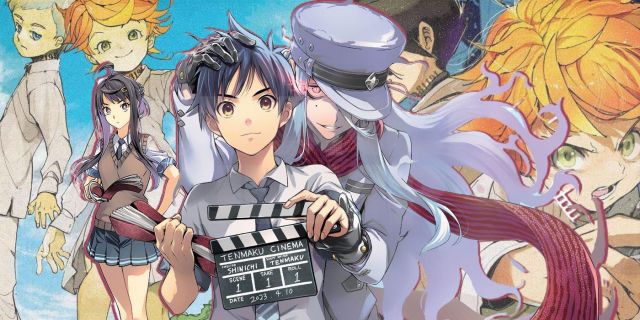There’s a certain thrill to seeing the characters of one mangaka’s work in another mangaka’s style. This holds especially true when the two mangakas have achieved similar levels of popularity. This thrill can also be invoked when two creators under the same brand use the same characters.
In Weekly Shonen Jump, for example, Tenmaku Cinema recently paid tribute to the characters from The Promised Neverland. This new series is being done by Yuto Tsukuda and Shun Saeki, who previously teamed up to bring Jump readers Food Wars. In other words, this shout-out to TPN is a chance for readers to see what the main cast would look like in the Food Wars style.
Where Do the Promised Neverland Kids Show Up?

The TPN cast made their appearance in Tenmaku Cinema Chapter 7, “The Director’s Job.” The Movie Research Club discussed how they could film their school and give off the illusion that it was near the ocean. Shinichi noted how common it is to use different locations, one to set the scene and another that makes people look like they’re in it. He cited the Grace Field House from the TPN live-action series, which used two different buildings for the interior and exterior. As part of this example, Emma, Ray, and Norman were all featured in new original drawings.
This isn’t the first time Shun Saeki has drawn characters from TPN. He previously drew Emma and other Shonen Jump Girls as part of a 2017 Valentine’s Day crossover. However, this was the first time Emma, Norman, and Ray were all shown together.
The best thing about this reference is that it didn’t need to happen. Shinichi could have referenced any other movie or live-action series and achieved the same effect. However, the writers had him reference TPN as a friendly shout-out to a fellow Shonen Jump mangaka.
What’s also cool about this reference is how it reaffirms the value of TPN. Many fans were disappointed by the series’ latter portion due to a drop in story quality in both the manga and the anime. This reference is a reminder of a time when TPN was good and how that part of the story can still be enjoyed on its own.
The reference was brief, but it was good to see the Grace Field children again. References like these are great ways to make the Shonen Jump catalog feel bigger. It also makes the artists more connected. It doesn’t happen often, so moments like these should be cherished when they co















Leave a Reply